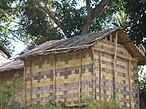House
**Historical and Cultural Aspects**:
– The term ‘house’ has roots in Old English and Proto-Germanic languages.
– Various languages, like Arabic and Maltese, have words related to ‘house.’
– The house symbolizes shelter and home in multiple cultures.
– Dutch architecture has influenced modern housing design.
– Different cultures have unique interpretations of the concept of ‘house.’
– Architecture reflects historical and cultural contexts.
**Architectural Development**:
– Roman architect Vitruvius proposed timber frame architecture.
– Dutch houses in the 17th century influenced modern house foundations.
– Different roofing systems are used in houses to prevent precipitation.
– House layouts have evolved over centuries to meet inhabitants’ needs.
– Prefabrication gained popularity in the early 20th century and post-World War II.
**Social and Legal Aspects**:
– A household is a social unit living in a house, which can include families, roommates, or individuals.
– Housing First and housing subsidies are social initiatives to assist with housing costs.
– Rent control regulates rental prices to ensure affordability.
– Legal issues like historical significance and construction restrictions impact houses.
– House numbering and identification methods are used to distinguish properties.
**Functional Evolution**:
– Manor Houses in the Middle Ages accommodated many people in communal lifestyles.
– The layout of houses has transformed over time to separate work from domestic life.
– Houses today typically include bedrooms, bathrooms, kitchens, and recreation rooms.
– Yards and outbuildings like garages provide additional space for relaxation and activities.
– Houses are built with consideration for modern living needs and social connectivity.
**Industrial and Technological Advancements**:
– Dutch houses in the 17th century embraced self-reliance and family-centered lifestyles.
– The 19th and 20th centuries saw changes in house layouts due to technological advancements.
– Technology has blurred the lines between personal and work life in modern homes.
– Construction materials like insulating concrete forms and steel framing have gained popularity.
– Home ownership is a common measure of prosperity and houses play a significant role in town planning.
A house is a single-unit residential building. It may range in complexity from a rudimentary hut to a complex structure of wood, masonry, concrete or other material, outfitted with plumbing, electrical, and heating, ventilation, and air conditioning systems. Houses use a range of different roofing systems to keep precipitation such as rain from getting into the dwelling space. Houses generally have doors or locks to secure the dwelling space and protect its inhabitants and contents from burglars or other trespassers. Most conventional modern houses in Western cultures will contain one or more bedrooms and bathrooms, a kitchen or cooking area, and a living room. A house may have a separate dining room, or the eating area may be integrated into the kitchen or another room. Some large houses in North America have a recreation room. In traditional agriculture-oriented societies, domestic animals such as chickens or larger livestock (like cattle) may share part of the house with humans.
The social unit that lives in a house is known as a household. Most commonly, a household is a family unit of some kind, although households may also have other social groups, such as roommates or, in a rooming house, unconnected individuals, that typically use a house as their home. Some houses only have a dwelling space for one family or similar-sized group; larger houses called townhouses or row houses may contain numerous family dwellings in the same structure. A house may be accompanied by outbuildings, such as a garage for vehicles or a shed for gardening equipment and tools. A house may have a backyard, a front yard or both, which serve as additional areas where inhabitants can relax, eat, or exercise.












